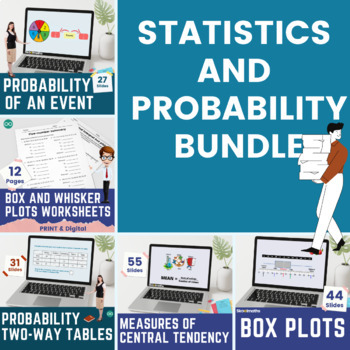Complete Statistics and Probability Bundle | Digital and Print
Skoolmaths - Math Science ELA Resources
409 Followers
Grade Levels
7th - 12th, Homeschool
Subjects
Resource Type
Standards
CCSS7.SP.A.2
CCSS7.SP.B.4
CCSS7.SP.C.5
CCSS7.SP.C.6
CCSS7.SP.C.7
Formats Included
- Zip
- Easel Activity
Pages
360 Interactive Slides + PDF Worksheets
Skoolmaths - Math Science ELA Resources
409 Followers
Easel Activities Included
Some resources in this bundle include ready-to-use interactive activities that students can complete on any device. Easel by TPT is free to use! Learn more.
Products in this Bundle (11)
showing 1-5 of 11 products
Description
This amazing statistics and probability bundle is all you need for your middle school to High school learners. From calculating averages using frequency tables to condition probability, your learners are definitely going to be immersed in their learning! Buy this high-engagement math bundle today and save hours of lesson planning time.
Interactive Digital lessons inside this bundle include:
- Measures of Central tendency
- Conditional Probability - Venn Diagrams
- Conditional Probability - Two-way tables
- Probability scale
- Box and Whisker Plots
- Pie Charts
- Scatter Plots
- Lines of Best Fit and Correlation
- Cumulative Frequency
- Stem and Leaf Diagrams
- Histograms
Printable worksheets inside this bundle include:
- Box and Whisker plots (PDF and Easel Activities)
- Conditional Probability - Two-way tables (PDF and Easel Activities)
Total Pages
360 Interactive Slides + PDF Worksheets
Answer Key
Included
Teaching Duration
N/A
Report this resource to TPT
Reported resources will be reviewed by our team. Report this resource to let us know if this resource violates TPT’s content guidelines.
Standards
to see state-specific standards (only available in the US).
CCSS7.SP.A.2
Use data from a random sample to draw inferences about a population with an unknown characteristic of interest. Generate multiple samples (or simulated samples) of the same size to gauge the variation in estimates or predictions. For example, estimate the mean word length in a book by randomly sampling words from the book; predict the winner of a school election based on randomly sampled survey data. Gauge how far off the estimate or prediction might be.
CCSS7.SP.B.4
Use measures of center and measures of variability for numerical data from random samples to draw informal comparative inferences about two populations. For example, decide whether the words in a chapter of a seventh-grade science book are generally longer than the words in a chapter of a fourth-grade science book.
CCSS7.SP.C.5
Understand that the probability of a chance event is a number between 0 and 1 that expresses the likelihood of the event occurring. Larger numbers indicate greater likelihood. A probability near 0 indicates an unlikely event, a probability around 1/2 indicates an event that is neither unlikely nor likely, and a probability near 1 indicates a likely event.
CCSS7.SP.C.6
Approximate the probability of a chance event by collecting data on the chance process that produces it and observing its long-run relative frequency, and predict the approximate relative frequency given the probability. For example, when rolling a number cube 600 times, predict that a 3 or 6 would be rolled roughly 200 times, but probably not exactly 200 times.
CCSS7.SP.C.7
Develop a probability model and use it to find probabilities of events. Compare probabilities from a model to observed frequencies; if the agreement is not good, explain possible sources of the discrepancy.





